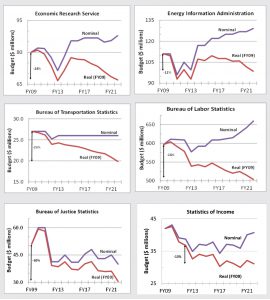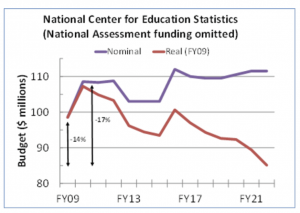Administration Releases FY23 Budget Request as Congress Finalizes FY22 Budget
Steve Pierson, ASA Director of Science Policy
Congress wrapped up its funding for the federal government for fiscal year 2022 (FY22) in March 2022, the sixth month of the fiscal year. With the Biden administration releasing its FY23 within a few weeks, Congress had to almost immediately start the process again.

Figure 1: The budgets for the BJS, BLS, BTS, EIA, ERS, and SOI in nominal and inflation-adjusted (real) dollars since FY09. SOI’s budget was restructured in FY12, making subsequent budget year comparisons to those of FY09–FY11 misleading.
Alphabet Soup
NIH — National Institutes of Health
NSF — National Science Foundation
AHRQ — Agency for Healthcare Research and Quality
BEA — Bureau of Economic Analysis
BJS — Bureau of Justice Statistics
BLS — Bureau of Labor Statistics
BTS — Bureau of Transportation Statistics
EIA — Energy Information Administration
ERS — Economic Research Service
NASS — National Agricultural Statistics Service
NCES — National Center for Education Statistics
NCHS — National Center for Health Statistics
NCSES — National Center for Science and Engineering Statistics
ORES — Office of Research, Evaluation, and Statistics
SOI — Statistics of Income
The National Institutes of Health and National Science Foundation both received 4 percent increases in FY22 over their FY21 levels, as shown in Table 1. Several statistical agencies also received 3–6 percent increases. The US Census Bureau’s budget was raised 20 percent to $1.35 billion for last-stage operations of the 2020 Decennial Census and initial planning for the 2030 Decennial Census, among other initiatives. The Bureau of Justice Statistics’ budget was cut 11 percent to $40 million.
Despite these encouraging increases for many statistical agencies, most have lost considerable purchasing power since FY09. The Bureau of Justice Statistics (-40 percent), Bureau of Labor Statistics (-16 percent), Bureau of Transportation Statistics (-26 percent), Energy Information Administration (-11 percent), Economic Research Service (-24 percent), and Statistics of Income Division (-13 percent since FY12) all saw double-digit percentage decreases (unless otherwise noted), as shown in the figures below. The National Center for Education Statistics has lost nearly 10 percent since FY09, 14 percent for the NCES statistics line (see Figure 2). The National Center for Health Statistics has lost 8 percent in purchasing power since FY09, 16 percent since FY10. Only the budgets for the Bureau of Economic Analysis and National Center for Science and Engineering Statistics have kept up with inflation (as measured by the GDP deflator).
President’s FY23 Request
In the president’s FY23 budget request, the second for the Biden administration, an increase of $4.3 billion (10 percent increase) is requested for the National Institutes of Health. $4 billion of that amount is to further the budget of the newly established Advanced Research Projects Agency for Health, which was funded for the first time in FY22 at $1 billion. The FY23 budget documents from the Department of Health and Human Services state the “NIH budget continues vital work to address the opioid crisis and end HIV” and “makes new investments in pandemic preparedness and nutrition research, establishes a Center for Sexual Orientation and Gender Identity Research, and also supports NIH’s work as part of the Cancer Moonshot.”
The same document says the Advanced Research Projects Agency for Health is modeled after the Defense Advanced Research Projects Agency and “will recruit visionary term-limited program managers who can identify and fund traditional and nontraditional partners to take on critical challenges that are unlikely to move forward quickly without this catalytic assistance.” (Hereafter, quoted material will be from the agency’s or host agency’s FY23 budget request documents.)
The $10.5 billion requested for the National Science Foundation is a 19 percent increase over its FY22 level. $880 million is requested for the Directorate for Technology, Innovation, and Partnerships created in FY22. According to NSF FY23, “TIP aims to advance emerging technologies to address societal and economic challenges and opportunities; accelerate the translation of research results from the lab to market and society; and cultivate new education pathways leading to a diverse and skilled future technical workforce comprising researchers, practitioners, technicians, and entrepreneurs.”
The FY23 NSF budget also proposes double-digit percentage increases for most of NSF’s six traditional directorates. The requested increases would be directed in six theme areas: climate and clean energy research; equity for underserved communities; discovery engine; emerging industries; research infrastructure; and organizational excellence/agency operations and award management.
The $26 million requested increase for the Agency for Healthcare Research and Quality is for “long COVID research and diagnostic safety research, the development of an all-payer claims database, and activities to evaluate the effects of telehealth on health care delivery and health outcomes.”
Moving to the statistical agencies, the National Center for Science and Engineering Statistics’ requested increase is to provide leadership “in government-wide evidence-building activities and initiatives, including standing up the first-ever standard application process for applying to access restricted-use data from statistical agencies and units, as well as implementing the proposed National Secure Data Service through the expansion of America’s DataHub.” The requested budget increase is accompanied by a request for six additional employees.

Table 1: The FY19–FY22 budgets and FY23 requests for NIH, NSF, AHRQ, and the 13 principal federal statistical agencies, including percentage increase of FY22 final over FY21 and FY23 request over FY22. †The NCHS budget was restructured starting in FY21 to account for $14 million previously routinely received from another account. The prior year budgets were adjusted to make them comparable. ‡The BLS request includes another $15 million for its relocation to Suitland, Maryland, to co-locate with BEA and the US Census Bureau. Relocation funding has been provided for FY20–FY22.
A 21 percent increase is requested for the Bureau of Economic Analysis, which also includes operations for the office of the undersecretary for economic affairs. Major changes “include program adjustments of $2.713 million to improve and expand new distributional measures, $5.221 million to develop new data to track American competitiveness in global supply chains, $2.055 million to develop a space economy satellite account, and $1.511 million to accelerate improved measures of the US health care sector.” Further, $9.3 million of the requested increase supports the implementation of the Evidence Act, additional capacity for the evaluation officer, and consolidation of the Federal Data Service activities under the undersecretary for economic affairs.
The administration requests $726 million for Bureau of Labor Statistics programs and $15 million for the agency’s relocation to the site of the Bureau of Economic Analysis and US Census Bureau in Suitland, Maryland. The $67 million in additional program funding includes $11 million to “rebuild statistical capacity across the agency to begin to restore staffing levels,” $15 million to “continue development of a new National Longitudinal Surveys youth cohort,” $10 million “to improve the Job Openings and Labor Turnover Survey data timeliness,” $1 million “to restore agricultural industries to the Occupational Employment and Wage Statistics program,” and $12 million “to produce production-quality thresholds to support the Census Bureau’s Supplemental Poverty Measure, to research the nature and construction of a consumption-based poverty measure, and to research a chained CPI for low-income households.”
The 13 percent requested increase for the Economic Research Service includes $2 million for climate science research and $6.5 million for “conducting a second round of the USDA’s National Household Food Purchase and Acquisition Survey.” For the National Agricultural Statistics Service, the $26 million includes $8 million for “climate science activities to meet the president’s climate goals” and $18 million for the Census of Agriculture.
The $1.5 billion requested for the US Census Bureau includes $160 million for the 2020 Census “to release its data products and final evaluations and assessments,” $252 million for the 2030 Census, an increase of $34 million for the Economic Census and Census of Governments, $25 million for Current Economic Statistics, $99 million for Enterprise Data Dissemination—including “an initiative to build evidence, evaluations, and improve underlying racial and ethnicity data”—and $246 million for the American Community Survey, including “an initiative to improve the measurement of sexual orientation and gender identity (SOGI) population in the ACS.”
The administration has also requested $10 million for the Bureau of Transportation Statistics. BTS is normally not included in the appropriations process, as it is funded from the Highway Trust Fund at levels determined by the authorizing committee. The requested funding would support the president’s FY23 initiatives to (i) “better understand equity as it relates to the transportation cost burden, multimodal access to key resources, and other equity considerations”; (ii) “measure the vulnerability of the transportation system to direct and indirect disruptions caused by extreme weather and other unexpected events”; and (iii) “collect small-area, equity-related data and develop/estimate outcome measures for use in the DOT Learning Agenda.” Any funding provided by Congress through appropriations would be the first such funding for at least a couple decades but would help alleviate the steep loss in purchasing power.
The request for the Bureau of Justice Statistics restores its budget to its FY21 level. The $45 million should be seen as intending to keep BJS funding flat, rather than a $5 million increase, because the ink would likely have been long dry on the administration’s proposed FY22 level for BJS when Congress decided on $40 million for BJS in FY22.
The requested levels for the Office of Research, Evaluation, and Statistics in the Social Security administration and the IRS Statistics of Income are modest in dollar increases.
To follow the FY23 budget developments, visit the ASA Science Policy blog posts FY23 NIH, NSF, and AHRQ Budget Developments and FY23 Statistical Agency Budget Developments. Also, follow @ASA_SciPol on Twitter and join the Count on Stats LinkedIn group, where you can network with fellow supporters of the federal statistical agencies, share your observations and perspectives, and receive relevant updates.


















